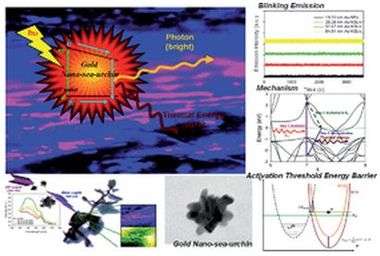October 25, 2010 report
Gold nanoparticles that make leaves glow in the dark

(PhysOrg.com) -- Researchers in Taiwan think they may eventually be able to replace street lamps with trees laced with gold nanoparticles that turn their leaves into bio-light-emitting diodes.
Light-emitting diodes (LEDs) are much more energy efficient than traditional light globes, but researchers in Taiwan led by Yen Hsun Su and colleagues at Academia Sinica in Taipei and the National Cheng Kung University in Tainan wanted to find a way of making LEDs that were even more efficient than those currently available. They succeeded by synthesizing gold nanoparticles and implanting them into leaves of the Bacopa caroliniana plant to induce bio-luminescence in them.
Bacopa caroliniana is a perennial aquatic or semi-aquatic creeping herb commonly used as an aquarium plant. The color of the leaves varies in proportion to the amount of light, turning bronze to almost red when exposed to high light levels.
The green pigment in leaves, chlorophyll, is bioluminescent when exposed to high wavelength (400 nanometers (nm)) ultra violet excitation, but the wavelength is much shorter for the photoluminescence of gold nanoparticles, and they emit light at 400 nm. The light is localized at a nanoscale and the nanoparticles made by the Taiwan team suppresses emission blinking, which is a problem already known in gold nanoparticles. Using their sea-urchin-shaped nanoparticles (dubbed nano-sea-urchins or NSUs), Su was able to excite chlorophyll in the leaves to emit red light.
Su said the bio-LEDs (light emitting diodes) might eventually be used to make trees lining roads luminescent at night, and since the light causes the chloroplast to conduct photosynthesis no energy source is needed and the plant will absorb CO2 for the process, which does not normally occur at night.
Su and his colleagues are looking at applying the same technique to other plant molecules and on trying to improve the efficiency of the process. Their work was reported in the journal Nanoscale.
More information: Influence of surface plasmon resonance on the emission intermittency of photoluminescence from gold nano-sea-urchins, Nanoscale, 2010, Advance Article, DOI:10.1039/C0NR00330A
© 2010 PhysOrg.com

















